La Mano
The Di Tella Institute According to Hernán Morán
No. 41 – Buenos Aires, August 2007
A few weeks ago, when actress Emilce Karl told Laura Batkis that there was a play related to the Di Tella Institute, she went to the Abasto Social Club to see Rotary and interviewed the author and director.
The sixties are in fashion and that period is reviewed from all areas of art. Hernán Moran writes and directs this play out of the frustration of those left out of the famous Institute.
What do you think the Di Tella was?
A very important outburst in relation to what was happening at the time, a very liberating movement. I had been researching this for a long time, and I was curious about everything they were doing. The Por qué son tan geniales (Why are they so great) poster that Edgardo Giménez, Dalila Puzzovio and Carlos Squirru put up on Florida Street is still very strong today.
And after Di Tella?
There was a huge cultural void that was difficult to overcome. I don’t want to sound pessimistic, but I believe that only now we are approaching something better.
The portion of the play related to art is very spot on…
As we rehearsed, we also began to do some research with the actors. And we were getting excited as we learned about the genius of the happenings. What Marta Minujín did, for example, was very stimulating.
How is the public’s reception of the play?
They are surprised that the work is based on something that could have happened in the sixties, which is very current.
In the play you simulate happenings…
Yes, they came out of drills and improvisations. In fact, there was only half of the play written, the other half I rewrote completely, mostly by an acting method rather than a playwright’s one. The idea was to work with the information. It was not a matter of memorizing a list of names but of facts and events.
In the play, you focus on artists who were not at the Di Tella, and there is a certain irony in the creation of the “EeHa operation center” where they are confined until they can conceive the project that will supposedly consecrate themselves.
Yes, because it is an unknown, and it leads to a very current and general topic which is the language of the artists themselves. The play, apart from being set in the sixties and having Di Tella as its center, has an axis, which is frustration as an aesthetic.
Do you have a background in visual arts?
Yes, I received my high school diploma from the Rogelio Yrurtia school in Mataderos, which has a background in Fine Arts. And theater was a bit of an accident. With my Fine Arts group, we started to make installations for one class, Morphology. The professor asked us to make a piece where we integrated several disciplines. From then on, a teacher came up with the idea of putting theater as an extracurricular class, we went on Saturdays. Afterwards, I signed up with some friends at the Ricardo Rojas Cultural Center, they quit and I continued. It was like entering another world.
And the playwriting?
It was a consequence and a need to tell. I started writing one day with the desire to create a play. I write what I do. We had a theater group, I brought some material, and that’s when we started.
How do you define your way of directing?
It’s very intuitive, it’s based on what I know I want and what I wrote, but I modify it according to the rehearsals.
And now what are you doing?
A semi-assembly that is part of the International Theatre Festival that takes place in September. We are eight directors who are making a kind of theatrical trailer based on a text by Peter Brook, Hay algo que me golpea (Something is hitting me). It was only a starting point and it was given to us by the festival committee. On the other hand, I’m rehearsing Hippocampus, which I wrote and which poses a double game between the paranormal and the psychological.
What was the process for Rotary like?
I started thinking about this play when I was studying Fine Arts. What came to me was that pop was a banal look at what art was supposed to be, a cheap propaganda of art. I had very bad comments. Like that pop artists were a bunch of crazy people who did things and all those ideas from the sixties.
Like art can’t be fun…
Precisely, for me, art does not involve flagellation, nor does it involve seriousness or formality. When art begins to be solemn it bores me.
There is a tone of criticism of the supposedly avant-garde position that occurs in all periods.
The side I do not like in any artistic proposal is when it becomes closed in on itself and hermetic, to the point of not allowing it to expand any further. I don’t want to get involved with the question of what is “popular” and all that, but I think it is more a decision of the artist, where he wants it to reach and to which public. And all that is in the artwork.
When the Di Tella closed, several artists left or decided to move away from artistic activity, and then somehow returned.
These are things that are repeated. Sometimes the endings of something are part of the same picture, and it’s good that they are. For me the best path to creativity is vulnerability. If you are constantly permeable to what is around you, everything is more interesting.
BY LAURA BATKIS
